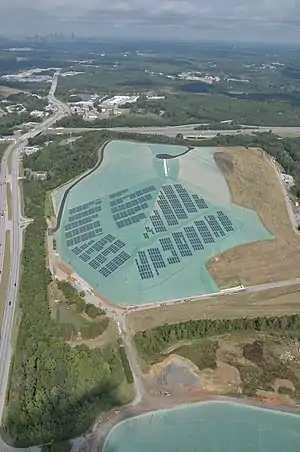Hickory Ridge Landfill
The Hickory Ridge Landfill is a municipal solid waste landfill located in Conley, Georgia, United States and privately owned by Republic Services. The site was opened in 1993 and closed in 2006; it contains nearly 9,000,000 cubic yards of waste.



| Hickory Ridge Landfill | |
|---|---|
 Photo of completed project taken on 9/23/2011. Atlanta can be seen in the background. | |

| |
| Country | United States |
| Location | Conley, Georgia |
| Coordinates | 33°39′54″N 84°20′06″W |
| Status | Operational |
| Construction began | 6/1/2011 |
| Commission date | 10/4/2011 |
| Construction cost | $5,000,000 |
| Owner(s) | Republic Services, Inc. |
| Solar farm | |
| Type | Ground Mount, Flexible PV |
| Site area | 48 acres |
| Power generation | |
| Units operational | 7,008 UNI-SOLAR PVL-144 photovoltaic panels |
| Nameplate capacity | 1,009 KW |
| Annual net output | 1.3 GWh |
| External links | |
| Website | carlisle |
| Commons | Related media on Commons |
The Hickory Ridge Landfill was capped in October 2011 with a dual-purpose landfill closure system referred to as an Exposed Geomembrane Solar Cover (EGSC). Developed by Carlisle Energy Services, the closure system provides renewable electricity via (photovoltaic) solar panels,
The project is the second installation of an EGSC and is the world's largest installed system of its kind. At the time of commissioning it was the largest solar photovoltaic system in the state of Georgia.[1] It also represents a $5,000,000 investment by Republic Services supported by a $2,000,000 grant from the Georgia Environmental Finance Authority (GEFA).[2]
System Details
The landfill closure system features a green, 60-mil scrim reinforced TPO (thermoplastic polyolefin) geomembrane cover 48 acres in total. A one-megawatt photovoltaic solar panel array is located on the southwest and southeast slopes of the landfill in an area approximately ten acres.[3]
The one-megawatt solar array features over 7,000 flexible solar laminates, composed of 36 laminates bonded one at a time to 12' wide by 120' long panels. Each photovoltaic roll was rated at 5,184 Wp DC.
The closure system meets infiltration and erosion criteria as prescribed by the United States Environmental Protection Agency, while also capturing the methane gas that is generated by the landfill, turning it into energy in a separate operation. The Georgia Environmental Protection Division approved the landfill closure system as a "Final" closure system.[4]
The photovoltaic system is actually composed of four separate arrays located on the 3H:1V slopes on the southeast and southwest areas of the landfill. Each photovoltaic array is rated for approximately 250kWp DC each; each with a 260kWp DC inverter.
The photovoltaic array is expected to generate 1,300,000 kWh in its first year of production.[5]
Awards
HDR Inc. received the following awards for their engineering work on this project:[6]
- 2012 - Grand Award, Engineering Excellence Awards, American Council of Engineering Companies of Georgia
- 2012 - Honor Award, Engineering Excellence Awards, American Council of Engineering Companies
- 2012 - Honor Award, American Academy of Environmental Engineers
American Environmental Group (AEG) received the 2013 Award of Excellence from the International Association of Geosynthetic Installers (IAGI) for their work as the geomembrane installer for the project
Related
- See actual energy produced by the Spectro PowerCap at the Hickory Ridge Landfill via the Online Remote Monitoring System
- View an actual time-elapsed construction video of the Hickory Ridge project
- Read a recent article about solar and landfills titled "Fill of Energy" that was published in PV Magazine in July 2012
- Read an announcement for a Spectro PowerCap that was recently installed at the Madison County Landfill in New York
- Mas Energy secured the landfill gas rights for the Hickory Ridge Landfill from Republic Services, supplying fuel to their 6.5 Megawatt combined heat and power facility located at Coca-Cola's Cogen Plant in Atlanta, GA.[7] Coca-Cola ranked third in the Top 20 Onsite Green Power Generators by the U.S. EPA Green Power Partnership as of July 5, 2012 mainly because of this system and the landfill gas from Hickory Ridge[8]
- CNN: Solar landfill provides a shining example
- Scientific American: Solar energy covers turn maxed-out landfills into solar farms
- EastAtlantaPatch: From Landfill To Solar Energy Farm
- Waste360: Preview of the Solar Installation at Hickory Ridge
- Fox News: Trash Today, Electricity Tomorrow, Thanks to Landmark Solar Energy Farm
References
- "Georgia's Largest Solar Project Is a Landfill-Covering System". Electrical Contractor. Retrieved 5/1/2011. Check date values in:
|accessdate=(help) - "From Landfill To Solar Energy Farm". 10/5/2011. EastAtlantaPatch.
- "Solar Powered Landfills". Energy Now News. Retrieved 2011-10-31.
- "Hickory Ridge Landfill Solar Energy Cover". HDR Inc.
- "Republic Services Caps Atlanta Landfill with Flexible Solar Cover". PR Newswire. Retrieved 10/4/2011. Check date values in:
|accessdate=(help) - "Hickory Ridge Landfill Solar Energy Cover". HDR Inc. Retrieved 2012. Check date values in:
|accessdate=(help) - "Coca-Cola Cogen Plant". Mas Energy. Retrieved 5 August 2012.
- Signet, Anna. "Landfill gas ranks Coca-Cola third in EPA green power users". Biomass Magazine. Retrieved 8/9/2012. Check date values in:
|accessdate=(help)